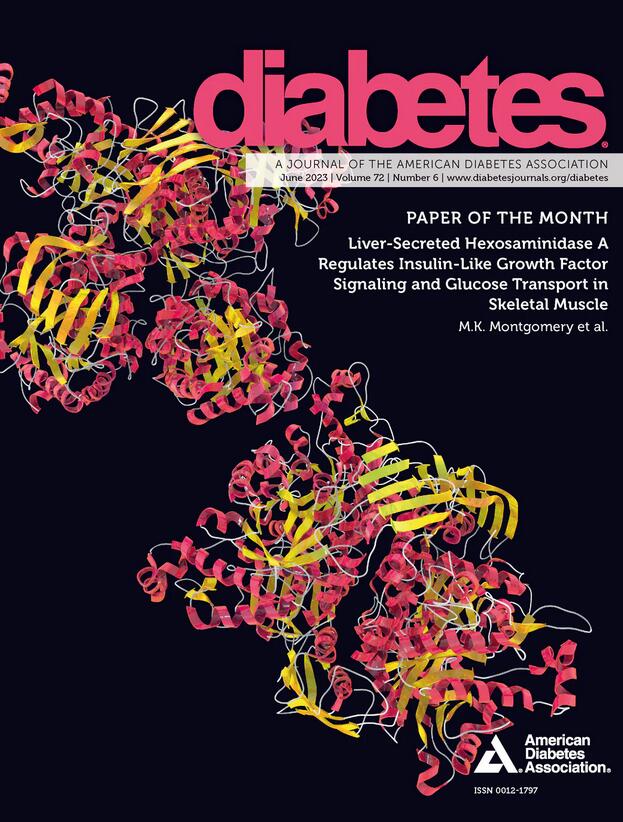Heterogeneity in Phenotype and Early Metabolic Response to Lifestyle Interventions in Type 2 Diabetes in China Using a Tree-Like Representation
IF 7.5
1区 医学
Q1 ENDOCRINOLOGY & METABOLISM
引用次数: 0
Abstract
Deciphering the heterogeneity of type 2 diabetes in prognosis and treatment effect is essential. We used a novel dimensionality reduction approach to describe the type 2 diabetes phenotype continuum and visualize the difference in lifestyle intervention efficacy in Chinese patients. Based on 17,816 participants with newly diagnosed type 2 diabetes (aged ≥40 years) from a nationwide cohort, 12 key phenotypes were residualized for age and sex to construct a two-dimensional tree structure. The tree demonstrated the continuous type 2 diabetes spectrum and region-specific characteristics, with a mixed phenotypic trunk and three extreme phenotypic branches. When mapping data from 325 participants with type 2 diabetes from a randomized controlled trial onto the original tree, lifestyle intervention induced a migration toward the left part of tree, indicating an overall metabolic improvement. Specifically, diet intervention was more effective for glycemic control in the upper part of the tree and featured moderate diabesity and elevated insulin, whereas exercise intervention was more effective for glycemic control in the left side of the tree and featured less adiposity and better overall metabolic status. In summary, this analysis depicted the tree structure representing the underlying pathophysiological features of patients with newly diagnosed type 2 diabetes and identified tree regions with different sensitivity to diet or exercise intervention. The results have the potential to aid lifestyle intervention selection. Article Highlights Deciphering the heterogeneity of diabetes is essential for prognosis prediction and treatment guidance, but current classifications are flawed because they lose continuous phenotypic information. We wanted to determine if the novel data reduction method, the data dimensionality reduction tree (DDRTree), is applicable to visualizing the phenotypic continuum, comorbid conditions, and lifestyle intervention effects in Chinese patients with type 2 diabetes. The DDRTree structure demonstrated the region-specific characteristics of type 2 diabetes. Diet intervention was more effective for glycemic control in the upper part of the tree, featuring moderate diabesity, whereas exercise intervention was more effective in the left side of the tree, featuring less adiposity and better overall metabolic status. The Chinese type 2 diabetes tree structure indicates individualized pathophysiology and guides the selection of lifestyle intervention.中国2型糖尿病患者对生活方式干预的表型和早期代谢反应的异质性
揭示2型糖尿病在预后和治疗效果上的异质性至关重要。我们使用一种新颖的降维方法来描述2型糖尿病表型连续体,并可视化中国患者生活方式干预效果的差异。基于来自全国队列的17,816名新诊断的2型糖尿病患者(年龄≥40岁),根据年龄和性别对12个关键表型进行残基化,以构建二维树结构。该树表现出连续的2型糖尿病谱和区域特异性特征,具有混合表型主干和三个极端表型分支。当将325名随机对照试验的2型糖尿病患者的数据映射到原始树时,生活方式干预诱导了向树左侧的迁移,表明整体代谢改善。具体而言,饮食干预对树上部的血糖控制更有效,表现为中度糖尿病和胰岛素升高,而运动干预对树左侧的血糖控制更有效,表现为脂肪较少,整体代谢状况更好。总之,该分析描绘了代表新诊断2型糖尿病患者潜在病理生理特征的树形结构,并确定了对饮食或运动干预不同敏感性的树形区域。研究结果可能有助于生活方式干预的选择。解读糖尿病的异质性对于预测预后和指导治疗至关重要,但目前的分类存在缺陷,因为它们失去了连续的表型信息。我们想确定数据降维树(DDRTree)这种新的数据降维方法是否适用于中国2型糖尿病患者的表型连续体、合并症和生活方式干预效果的可视化。DDRTree结构显示了2型糖尿病的区域特异性特征。在树的上部,饮食干预对血糖控制更有效,表现为中度糖尿病,而在树的左侧,运动干预更有效,表现为脂肪较少,整体代谢状况较好。中国2型糖尿病树状结构提示个体化病理生理,指导生活方式干预的选择。
本文章由计算机程序翻译,如有差异,请以英文原文为准。
求助全文
约1分钟内获得全文
求助全文
来源期刊

Diabetes
医学-内分泌学与代谢
CiteScore
12.50
自引率
2.60%
发文量
1968
审稿时长
1 months
期刊介绍:
Diabetes is a scientific journal that publishes original research exploring the physiological and pathophysiological aspects of diabetes mellitus. We encourage submissions of manuscripts pertaining to laboratory, animal, or human research, covering a wide range of topics. Our primary focus is on investigative reports investigating various aspects such as the development and progression of diabetes, along with its associated complications. We also welcome studies delving into normal and pathological pancreatic islet function and intermediary metabolism, as well as exploring the mechanisms of drug and hormone action from a pharmacological perspective. Additionally, we encourage submissions that delve into the biochemical and molecular aspects of both normal and abnormal biological processes.
However, it is important to note that we do not publish studies relating to diabetes education or the application of accepted therapeutic and diagnostic approaches to patients with diabetes mellitus. Our aim is to provide a platform for research that contributes to advancing our understanding of the underlying mechanisms and processes of diabetes.
 求助内容:
求助内容: 应助结果提醒方式:
应助结果提醒方式:


